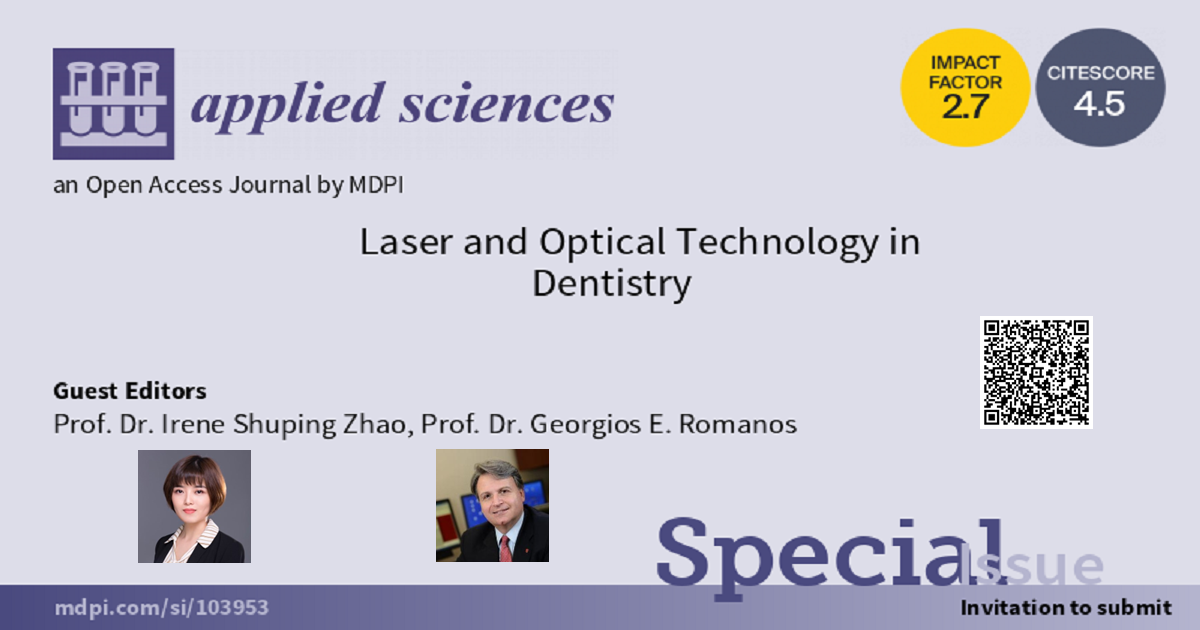Laser and Optical Technology in Dentistry
A special issue of Applied Sciences (ISSN 2076-3417). This special issue belongs to the section "Applied Dentistry and Oral Sciences".
Deadline for manuscript submissions: closed (30 September 2023) | Viewed by 9295

Special Issue Editors
2. Faculty of Dentistry, University of Hong Kong, Hong Kong 999077, China
Interests: fluoride; dental caries; silver diamine fluoride; laser
Interests: peri-implantitis; lasers; advances in material research; bone regeneration; materials; periodontal regeneration
Special Issues, Collections and Topics in MDPI journals
Special Issue Information
Dear Colleagues,
This Special Issue provides a forum for the publication of papers on the technical, experimental, and clinical aspects of the use of dental lasers, including lasers in operative dentistry, cariology, periodontology, endodontics, implantology, prosthodontics, orthodontics, aesthetic dentistry, and oral surgery. In addition, this Special Issue will publish papers on the dental application of new lasers, basic laser–tissue interactions, photobiomodulation, photodynamic therapy, low-level laser therapy, photodiagnostics, and temporomandibular joint and muscle disorders and TMJ pain management.
Prof. Dr. Irene Shuping Zhao
Prof. Dr. Georgios E. Romanos
Guest Editors
Manuscript Submission Information
Manuscripts should be submitted online at www.mdpi.com by registering and logging in to this website. Once you are registered, click here to go to the submission form. Manuscripts can be submitted until the deadline. All submissions that pass pre-check are peer-reviewed. Accepted papers will be published continuously in the journal (as soon as accepted) and will be listed together on the special issue website. Research articles, review articles as well as short communications are invited. For planned papers, a title and short abstract (about 250 words) can be sent to the Editorial Office for assessment.
Submitted manuscripts should not have been published previously, nor be under consideration for publication elsewhere (except conference proceedings papers). All manuscripts are thoroughly refereed through a single-blind peer-review process. A guide for authors and other relevant information for submission of manuscripts is available on the Instructions for Authors page. Applied Sciences is an international peer-reviewed open access semimonthly journal published by MDPI.
Please visit the Instructions for Authors page before submitting a manuscript. The Article Processing Charge (APC) for publication in this open access journal is 2400 CHF (Swiss Francs). Submitted papers should be well formatted and use good English. Authors may use MDPI's English editing service prior to publication or during author revisions.
Benefits of Publishing in a Special Issue
- Ease of navigation: Grouping papers by topic helps scholars navigate broad scope journals more efficiently.
- Greater discoverability: Special Issues support the reach and impact of scientific research. Articles in Special Issues are more discoverable and cited more frequently.
- Expansion of research network: Special Issues facilitate connections among authors, fostering scientific collaborations.
- External promotion: Articles in Special Issues are often promoted through the journal's social media, increasing their visibility.
- Reprint: MDPI Books provides the opportunity to republish successful Special Issues in book format, both online and in print.
Further information on MDPI's Special Issue policies can be found here.






